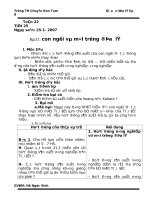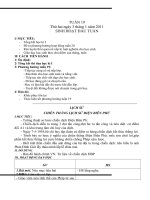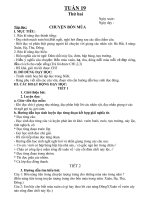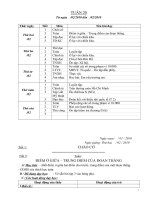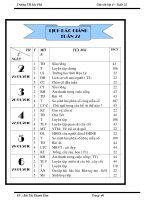Bài soạn GIÁO ÁN 8 - TUẦN 22
Bạn đang xem bản rút gọn của tài liệu. Xem và tải ngay bản đầy đủ của tài liệu tại đây (289.2 KB, 10 trang )
GIÁO ÁN TIẾNG ANH LỚP 8 NĂM HỌC 2010 – 2011 – HỌC KÌ II
==========================================================================
Tuần 22
Tiết 64
Ngày soạn: 12/ 01 / 2011
Ngày dạy : 24 / 01 / 2011
Unit 10: RECYCLING
Lesson 2: Speak + Listen
I. Objectives: By the end of the lesson, Ss will be able to:
• Know some verbs relating to recycling.
• Practice present simple and future simple.
• Learn some words relating to making compost.
• Practice in giving and responding to instructions.
II. Language content
• Vocabulary: fertilize, compost, fabric, leather
• Grammar: What can we do with ……………? / What will we do with ……………..?
III. Method
• Individually.
• Ask – answer.
• Pair works.
• Explanation.
IV. Teaching aids:
• Pictures and posters.
• Tape recorder.
• Flashcards.
• Books and notebooks.
V. Procedure:
1. Warm up (7 minutes)
Teacher’s activities Students’ activities
- Give the game of “Network”
- Draws the network with an example on the board and use it as a game.
- Divides class into two groups. Asks each group to send one representative to go to the board. Each
representative has to write down as quickly as possible all the things they know relating to
recycling. The person who has more correct answers and finish first will be the winner.
===========================================================================
TRƯỜNG T.H.C.S GIANG PHONG – CƠ SỞ 2 GIÁO VIÊN TẠ THỊ
MINH
GIÁO ÁN TIẾNG ANH LỚP 8 NĂM HỌC 2010 – 2011 – HỌC KÌ II
==========================================================================
Things for recycling
- Introduces and tells the aims of the lesson:
- Shows the picture in the textbook and asks the
students some questions:
+ What is it? (garbage)
- Play the game in two teams.
- Look at the poster with the network.
- The members of the two teams go to the board
and write the words as many as possible.
- Listen to the teacher’s introduction.
- Look at the pictures in page 91.
- Answer teacher’s questions.
[
+ Can you tell me the names of things from the garbage?
+ What can we do with them?
- Says: Today we continue to learn Unit 10: RECYCLING,
Section: Speak. In this lesson, we will talk about things and
how to protect the environment and save natural resources by
recycling.
2. Speaking (18 minutes)
* Pre – speaking
- Pre-teaches new words:
+ fertilize (v) (explanation)
(Farmer often use fertilizer to fertilize their fields. What does
it mean?)
+ compost (n) (using questions)
(What do we call the fertilizer made from spoiled food,
leaves, vegetable matter…?)
+ fabric (n) (using real objects: clothes)
(What are these clothes made of?)
+ leather (n) (using questions)
(Our shoes, sandals are often made of …?)
- Uses ‘Slap the board’ to check the students’ understanding of
new words.
- Dictation list:
- Tells the students they are going to listen to the words for
items and put them into the right groups.
- Draws the table on the board and asks the students to copy it.
- Tells the students to listen to the words and put them in the
I. Speak
1. New words:
+ fertilize (v)
+ compost (n)
+ fabric (n)
+ leather (n)
- Listen to the teacher’s explanation and give the Vietnamese
means of words.
- Repeat individually.
- Repeat in chorus.
- Copy down.
- Listen to the teacher.
- Prepare the posters.
- Look at the poster on the board.
- Work in four groups to complete the table.
===========================================================================
TRƯỜNG T.H.C.S GIANG PHONG – CƠ SỞ 2 GIÁO VIÊN TẠ THỊ
MINH
GIÁO ÁN TIẾNG ANH LỚP 8 NĂM HỌC 2010 – 2011 – HỌC KÌ II
==========================================================================
right column.
Group Items
Paper
Glass
Plastic
Metal
Fabric
Leather
Vegetable
matter
- Models some words.
- Reads the words (in the table below) aloud, slowly.
- After listening, asks the students to work in pairs and gives
their answers.
Group Items
Paper Used paper (books, old newspaper,
cardboard boxes)
Glass (bottles, glasses, jars)
Plastic (plastic bags, plastic bottles)
Metal (food cans, drinking tins)
Fabric Clothes (cloth bags, material)
Leather (shoes, sandals, schoolbags)
Vegetable
matter
Fruit peels (vegetables, rotten fruits)
- Read the item in the table loudly and correct the mistakes.
- Work in pairs to make the dialogues as examples in the book.
* While – speaking:
- Puts the dialogue chart on the board.
- Elicits the exchanges from the students.
- Has some pairs produce the dialogue before going to another
exchange.
- After finishing the dialogue, asks a good pair to demonstrate
the whole dialogue.
- Asks the students to work in pairs, replacing the information
with the words in the dictation list.
- Goes around the class to help the students to practice the
dialogues.
- Checks some pairs.
2. Practice
- Look at the dialogue.
- Two pairs read the dialogue.
- Two good students read the dialogue.
- Make new dialogue by using the model.
3. Listening (10 minutes)
* Pre – listening
II. Listen
===========================================================================
TRƯỜNG T.H.C.S GIANG PHONG – CƠ SỞ 2 GIÁO VIÊN TẠ THỊ
MINH
GIÁO ÁN TIẾNG ANH LỚP 8 NĂM HỌC 2010 – 2011 – HỌC KÌ II
==========================================================================
- Ask Ss to retell how to make compost in the fact.
- Now, please look at the part Listen in page 91 and show the
new words.
II. While – listening
- Ask Ss to listen to the tape then choose the correct answers
for the information.
- Call some Ss to read their answers.
- Ask Ss to check the answer by listening once more sentence
by sentence.
- Give the correct answer.
a) What type of garbage can you put in the compost?
b) Where is the best place for a compost heap?
c) Should you water the compost?
d) How long does it take before you can use the compost?
- Some Ss give their ideas.
1. New words:
+ compost (n)
+ vegetable matter (n)
+ shade (n)
2. Practice
- Listen to the tape then do exercise individually.
- Some Ss read their answers.
- Check the answers.
- Copy down.
A. all the vegetable matter.
B. a place that gets sun and shade.
A. No
B. six months.
4. Production (7 minutes)
* Discussion:
- Asks the students to discuss the question in groups of 4.
“What should you do to protect the environment and save
natural resources as you are students?”
- Asks the students to answer some questions relating to the
lesson.
- Work in groups of four.
- Give their ideas.
- Answer the questions.
5. Homework (3 minutes)
• Learn the lesson well.
• Do exercises 3, 4 in the workbook (p. 60)
• Prepare Unit 10: Read
Tuần 22
Tiết 65
Ngày soạn: 12/ 01 / 2011
Ngày dạy : 26 / 01 / 2011
Unit 10: RECYCLING
Lesson 3: Read + Language focus 1, 2
I. Objectives: By the end of the lesson, Ss will be able to:
• Get familiar with the passive form in the present simple tense.
• Talk about recycling.
===========================================================================
TRƯỜNG T.H.C.S GIANG PHONG – CƠ SỞ 2 GIÁO VIÊN TẠ THỊ
MINH
GIÁO ÁN TIẾNG ANH LỚP 8 NĂM HỌC 2010 – 2011 – HỌC KÌ II
==========================================================================
• Be aware of the importance of protecting the environment and saving natural resources.
II. Language content
• Vocabulary: tire, pipe, floor covering, refill, deposit, melt , dung, ….…….
• Grammar: The passive voice.
III. Method
• Individually.
• Ask – answer.
• Pair works.
• Explanation.
IV. Teaching aids:
• Pictures and posters.
• Tape recorder.
• Flashcards.
• Books and notebooks.
V. Procedure:
1. Warm up (7 minutes)
Teacher’s activities Students’ activities
- Give the game of “ Bingo”
- Writes on the board things that can be recycled.
- Calls out the words until someone has ticked all the five
words and shouts “Bingo”. He /She wins the game.
- Introduces and tells the aims of the lesson:
- Asks the students to answer the questions:
“Can you tell me some ways of recycling?”
- Says: Today we continue to learn Unit 10: RECYCLING. In
this lesson, we will learn a text about recycling facts and get
familiar with the passive form in the present simple tense.
- Plays the game individually.
- Choose 5 out of them and write them down on their pieces
of paper.
- Tick x in the table if there are words the teacher says.
- Listen to the teacher.
- Answer teacher’s questions:
- Listen to the teacher’s introduction.
2. Pre – reading (7 minutes)
- Pre-teaches new words following steps and principles of
teaching words.
+ tire (n) (using pictures)
+ pipe (n) (using explanation)
+ floor covering (n) (using translation)
+ refill (v) (using explanation)
+ deposit (n) (using translation)
+ melt (v) (using explanation)
I. New words:
+ tire (n)
+ pipe (n)
+ floor covering (n)
+ refill (v)
+ deposit (n)
+ melt (v)
+ dung (n) (using translation)
+ share (v) (using translation)
- Introduces quickly the passive form in the present simple
tense by using handouts.
- Checks understanding of the new words and phrases: What
and Where.
- Ask Ss to read the examples then retell the form of the
passive voice.
+ Active: People throw away millions of cars every year.
+ Passive: Millions of cars are thrown away every year.
- Open prediction:
- Now, you are going to read a page in a newspaper giving
some recycling facts to protect the environment.
- Ask students to guess what they are going to read.
“What do people do with used things?”
+ dung (n)
+ share (v)
- Listen to the teacher’s introduction.
- Play game individually.
II. Structure:
- Review the use of passive voice.
Form: S + be + P.P ………….
- Listen to the teacher.
===========================================================================
TRƯỜNG T.H.C.S GIANG PHONG – CƠ SỞ 2 GIÁO VIÊN TẠ THỊ
MINH
